In this post, you will learn how to bring one of the smallest birds in North American, the ruby-crowned kinglet, into your winter garden. With its round little body, twitchy movements, and doe-eyed face, the ruby-crowned kinglet may also be one of the cutest birds you’ll encounter anywhere.
* All photos on this page were taken by me unless otherwise noted. Please provide content and photo credits to thesouthernwildgarden.com.
** The Southern Wild Garden is supported by readers like you! Some links found on this website may be affiliate links, which means I may get a small commission, at no additional cost to you, if you buy a product through one of my links. And as an Amazon Associate, I earn from qualifying purchases through links to Amazon. I only recommend products that I use and love.
Why ruby-crowned kinglets?
While we are graced with a variety of lovely birds that reside in the South year-round, we are also lucky to have some delightful winter visitors that add some additional color to our garden flock. Our feeder regulars like northern cardinals, red-bellied woodpeckers, and tufted titmice will be joined by squabbling flocks of American goldfinches, rusty-capped chipping sparrows, and the especially darling ruby-crowned kinglets.
When my significant other looked out the window and asked me what the little wind-up-toy-looking bird was on the porch, I immediately knew he was referring to the ruby-crowned kinglet that likes to frantically hunt for tiny bits of seed that larger birds drop on the deck from hanging feeders. The ruby-crowned kinglet’s quick mechanical movements as it hops, pecks and flits its way along the ground are absolutely reminiscent of a cartoon character.
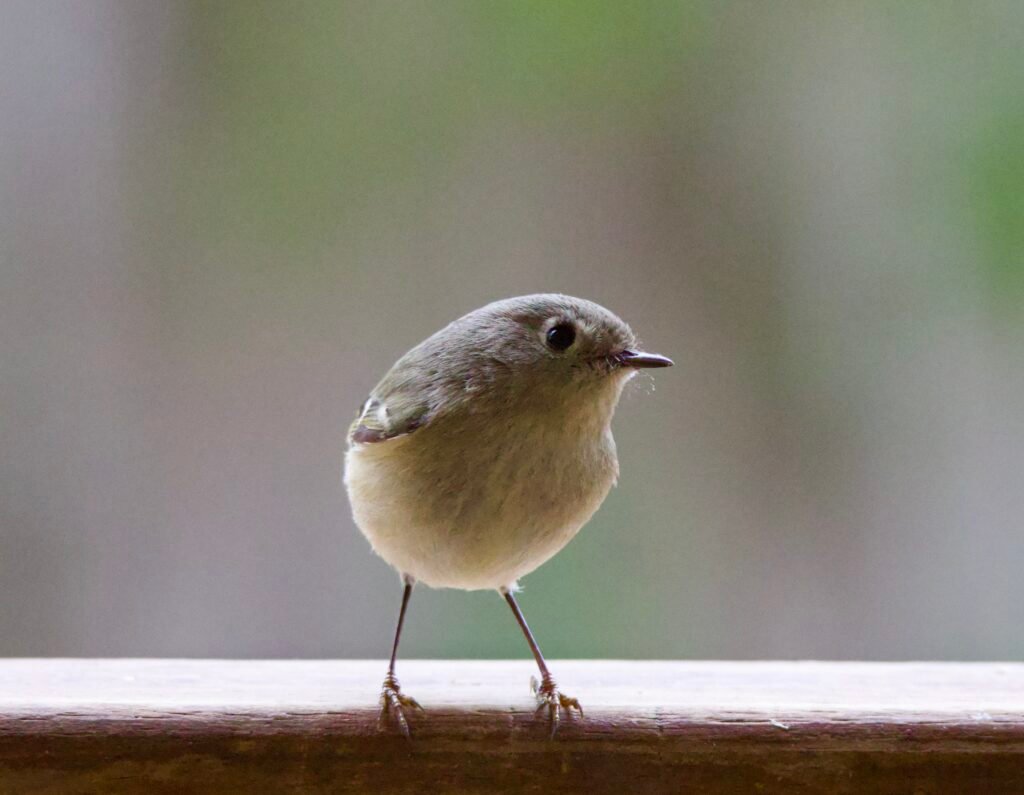
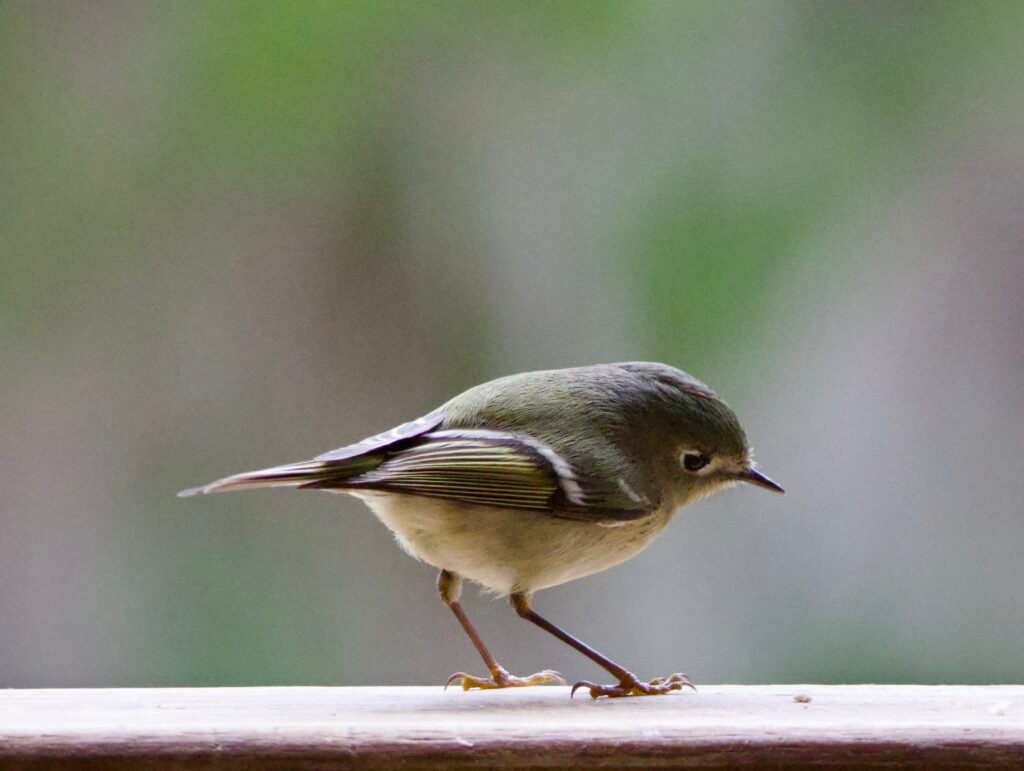
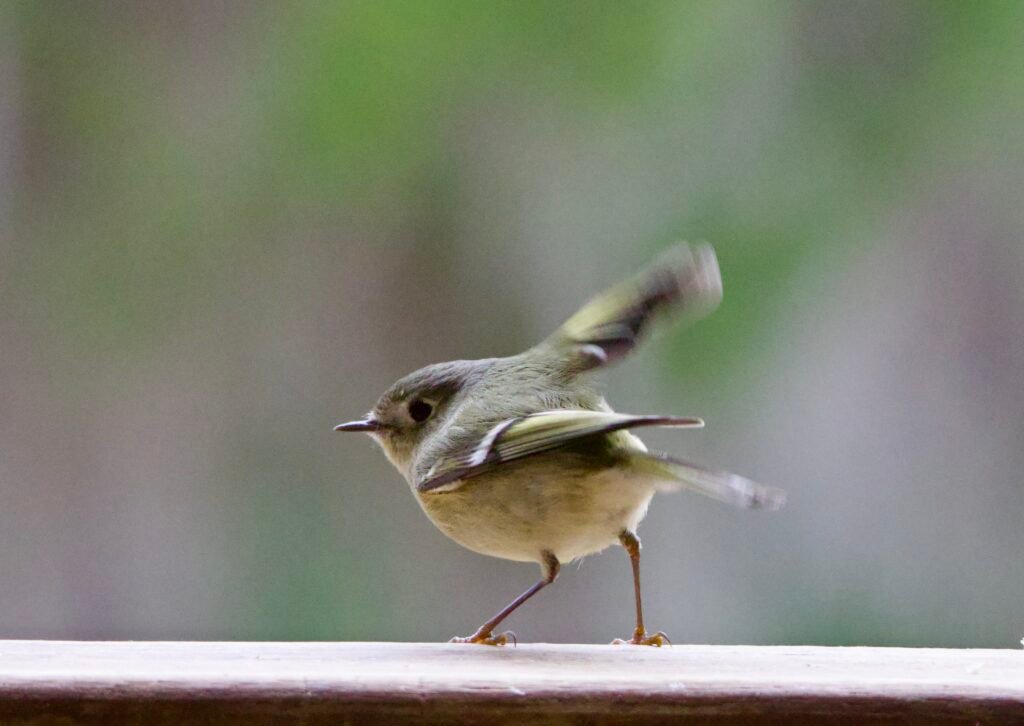
Wind up toy or ruby-crowned kinglet?
With its tiny stature, round body, lack of visible neck, and kewpie doll eyes, the ruby-crowned kinglet is a bird you’d like to put in your pocket as a little treasure to pull out when you need a smile. When you finally see a male reveal its brilliant ruby crest, you’ll realize this is also a dramatic bird whose personality far exceeds its diminutive size.
What are ruby-crowned kinglets?
Kinglets are very small songbirds in the Family Regulidae, a name derived from the Latin word regulus meaning little king or prince, a reference to the colorful crowns of birds in this family. There are 6 species of Regulidae worldwide, 2 of which are found in North America, the golden-crowned kinglet (Regulus satrapa)and the ruby-crowned kinglet (Corthylio calendula).
The golden-crowned kinglet and the ruby-crowned kinglet are both small greyish-green birds with obvious white wing bars and white eye rings. The coloration of the crown on the males’ heads differ in accordance to their names with the ruby-crown kinglet’s scarlet to red-orange crest only visible when he raises the feathers in agitation or excitement. When the crown is concealed, male and female kinglets look the same.
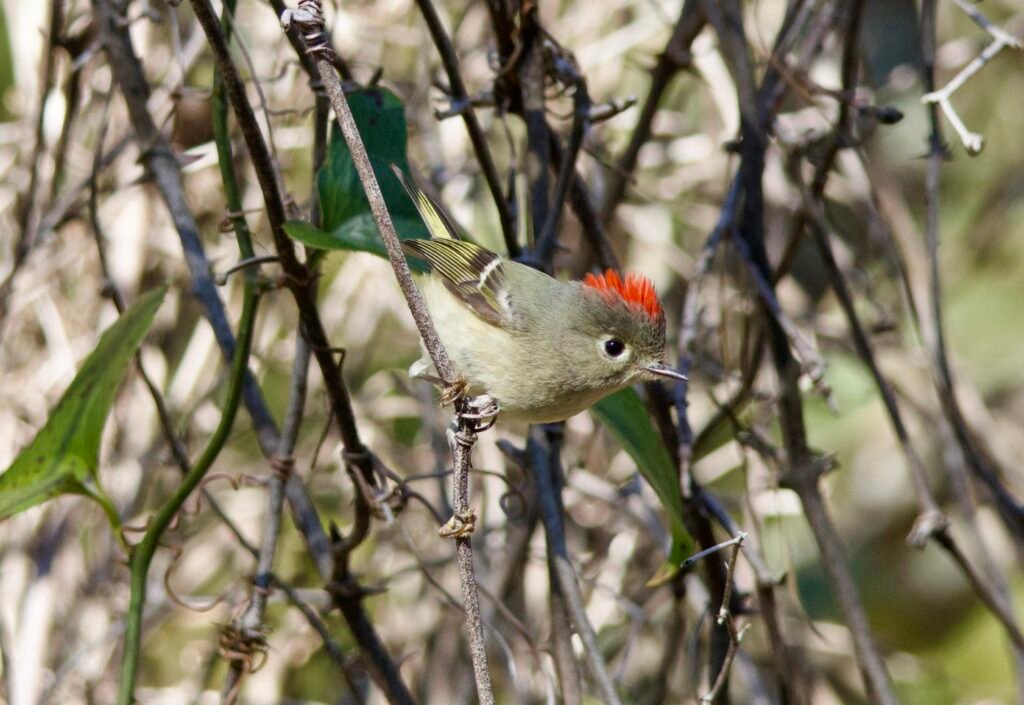
At 5 to 10 grams and about 4 inches long, a ruby-crowned kinglet weighs less than 4 pennies and is smaller than any other bird you’ll find in the South except ruby-throated hummingbirds. Always on the move, these tiny energetic birds relentlessly hunt for insects along the outer branches of trees. Ruby-crowned kinglets constantly flick their wings as they flitter through the trees, a behavior that can be relied upon to identify this little bird when it comes to your garden.
Ruby-crowned kinglets breed at northern latitudes in Canada and Alaska and in western mountain regions. They build nests very high in trees, sometimes up to 100 feet above ground, so very little is known about their breeding behavior. One of the remarkable facts about ruby-crowned kinglets is that females may lay up to 12 eggs in a single clutch, which adds up to more than her body weight in eggs. Another notable attribute of these tiny birds is the male’s distinctive song. Male ruby-crowned kinglets establish breeding territories by singing a long, complex series of notes that is astonishingly loud for such a minute bird.


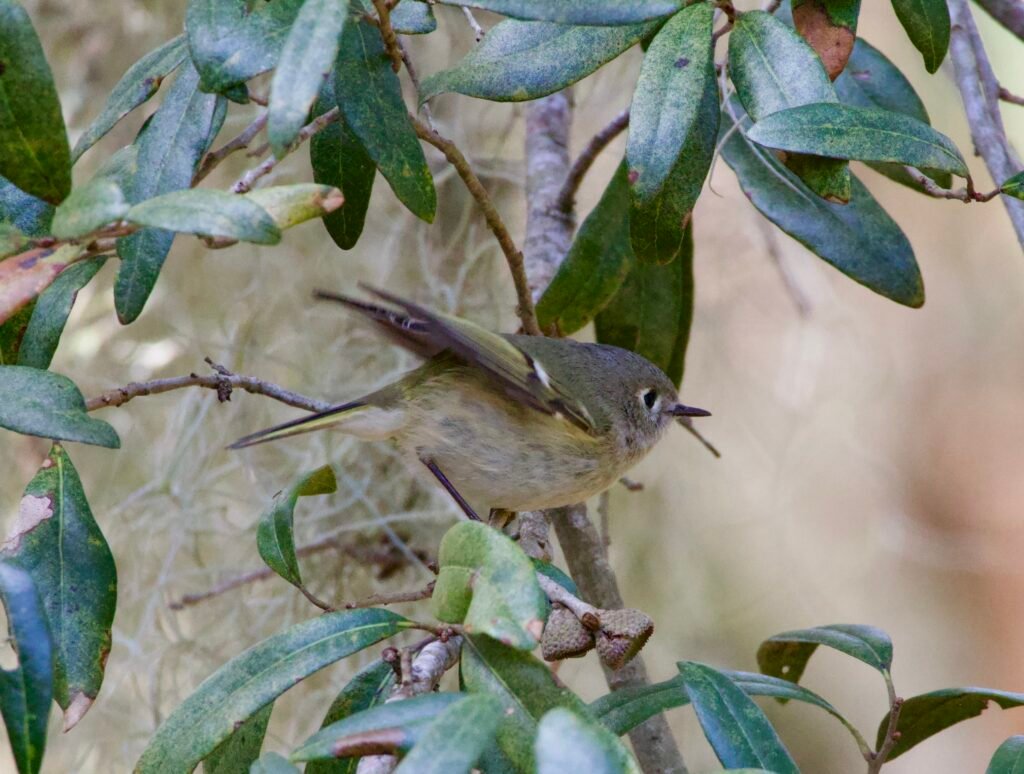
Look for a tiny, busy bird flicking its wings and find a ruby-crowned kinglet
If you live in the South, you will probably not have the opportunity to hear ruby-crowned kinglets singing from your trees. But when they arrive in your garden in the winter, you will hear their distinctive two note call if you listen for it. Described as sounding like “jid-jit”, the ruby-crowned kinglet’s call is fast and buzzy and could be mistaken as coming from an insect. When you hear it, scan the trees for a busy little greenish bird and you’ll find your ruby-crowned kinglet.
While preferring evergreen forest in the North in the summer, ruby-crowned kinglets may be found in a variety of low elevation woodland habitats during the winter months including parks and gardens. Their winter range extends across much of the Lower 48 United States and Mexico except the Midwest and Great Lakes regions.
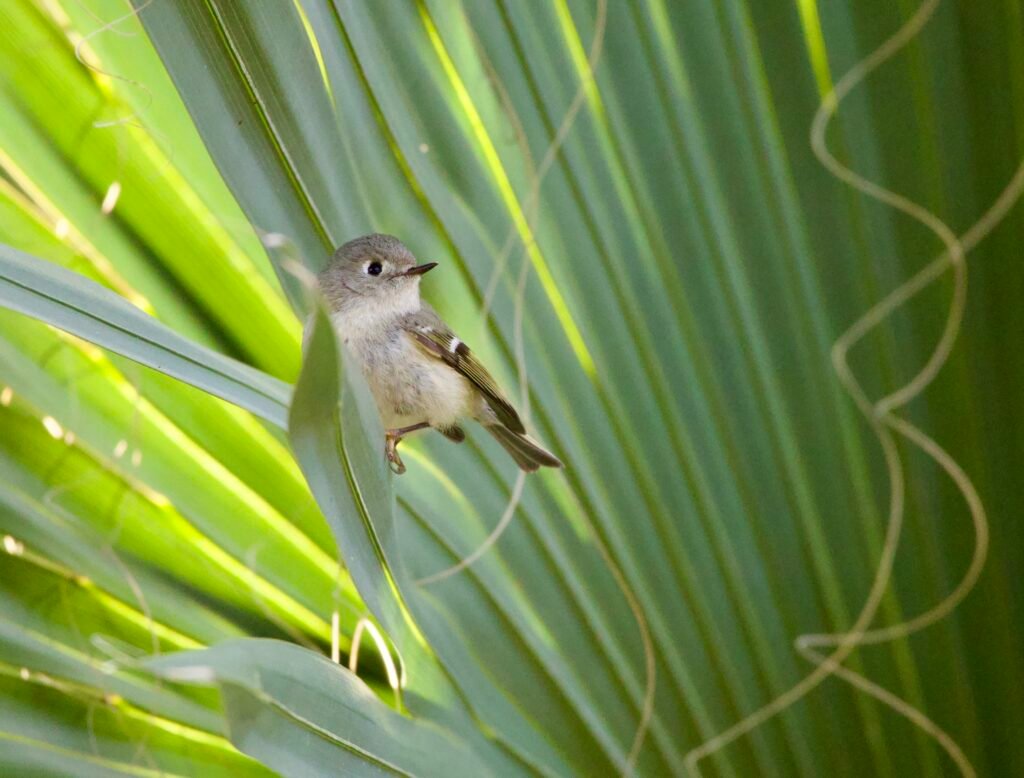
How to attract ruby-crowned kinglets?
Ruby-crowned kinglets fly south in the fall with peak numbers moving in October. I generally do not begin to see ruby-crowned kinglets at my feeders in southern Georgia until after the New Year when it suddenly seems like they are everywhere. While apparently strictly insectivorous during the summer, they will eat a more diverse diet in the winter including berries, seeds, and even sap. In my yard, ruby-crowned kinglets love suet and bits of chipped sunflower and peanuts the larger birds drop in seed trays and on my porch.
Summary: Ruby-crowned kinglet
| Scientific name | Corthylio calendula |
| Timing | October through April in the Southeast |
| Habitat | Diverse but prefer habitat structure with mid-story trees and shrubs |
| Food | Primarily insects with some fruit, seed, and sap |
| Feeders | Suet, peanut pieces, chipped sunflower, mealworms |
Habitat
While ruby-crowned kinglets will eat at feeders, they still depend primarily on insects to meet their energetic needs. Supporting insect populations by planting native trees and shrubs and limiting use of pesticides will make it more likely ruby-crowned kinglets will spend time in your garden and find your feeders. Ruby-crowned kinglets in the southeast appear to prefer habitats with diverse mid-story structure, so providing understory trees and shrubs will make them happy. In one study, ruby-crowned kinglets were observed most frequently in shrubs and small trees between 5 and 15 feet above ground.
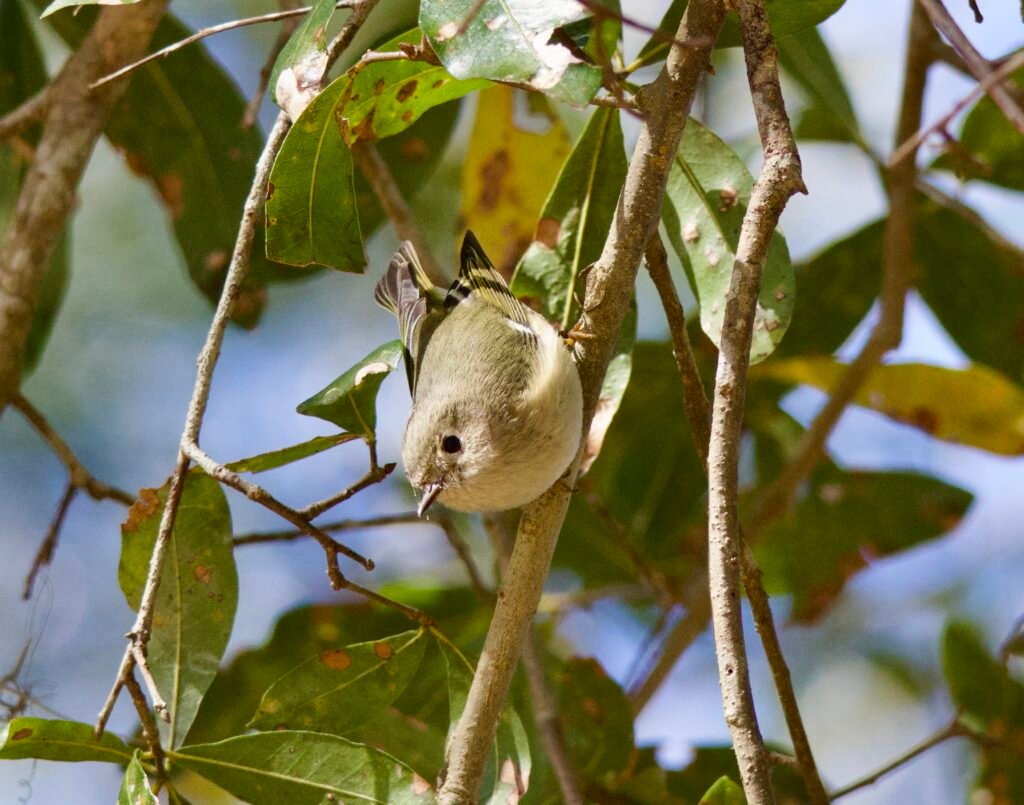
Ruby-crowned kinglets will apparently eat a variety of berries in the winter including wax myrtle, dogwood, poison-oak and ivy, and elderberry. A researcher studying the foraging ecology of birds in Georgia observed ruby-crowned kinglets gleaning insects from the leaves of wax myrtles more frequently than any other plant. So wax myrtles are apparently attractive to ruby-kinglets for their fruit as well as for the insects they harbor.
Wax myrtles (Morella cerifera) are evergreen shrubs that may grow up to 20 feet in height but are usually between 6 -12 feet tall. Named for their waxy, blue-grey berries, wax myrtles are dioecious meaning there are separate male and female plants and only the females will produce berries. Frequently found for sale at nurseries, wax myrtles are popular landscape plants for use as hedges or for screening. Wax myrtles are fairly adaptable to a variety of growing conditions, happy in full sun to part shade, as well as being both drought and flood tolerant once established. Lots of birds will find wax myrtle berries attractive, including Myrtle warblers who were named after the plant. In addition, wax myrtles are the larval host of the red-banded hairstreak butterfly.
Bird feeders
As a tiny bird, kinglets eat tiny things. Chipped sunflower seed in a small platform or dish feeder works well since they can find smaller pieces of seed to eat. I also often observe ruby-crowned kinglets checking for bits of seed or peanut in the seed trays attached to my tube feeders.
Ruby-crowned kinglets also love suet. While they will try to peck at a block of suet, they tend to be more successful picking up little crumbs that fall off the block when larger birds feed. Having a suet feeder that has a tray to catch pieces will be very attractive to kinglets. I have this simple cylinder suet feeder by Mr. Bird and was able to find a plastic tray for the bottom at Wild Birds Unlimited, but I haven’t been able to find a similar tray for sale online. I’ve also added a weather dome to my suet feeder to help keep it drier and hopefully less prone to molding. The only cylinder suet feeder I’ve found online that has a built in tray that might work in a similar fashion to mine is the Tidy Cylinder Feeder from Wild Birds. I’m not sure why they don’t make more with trays.
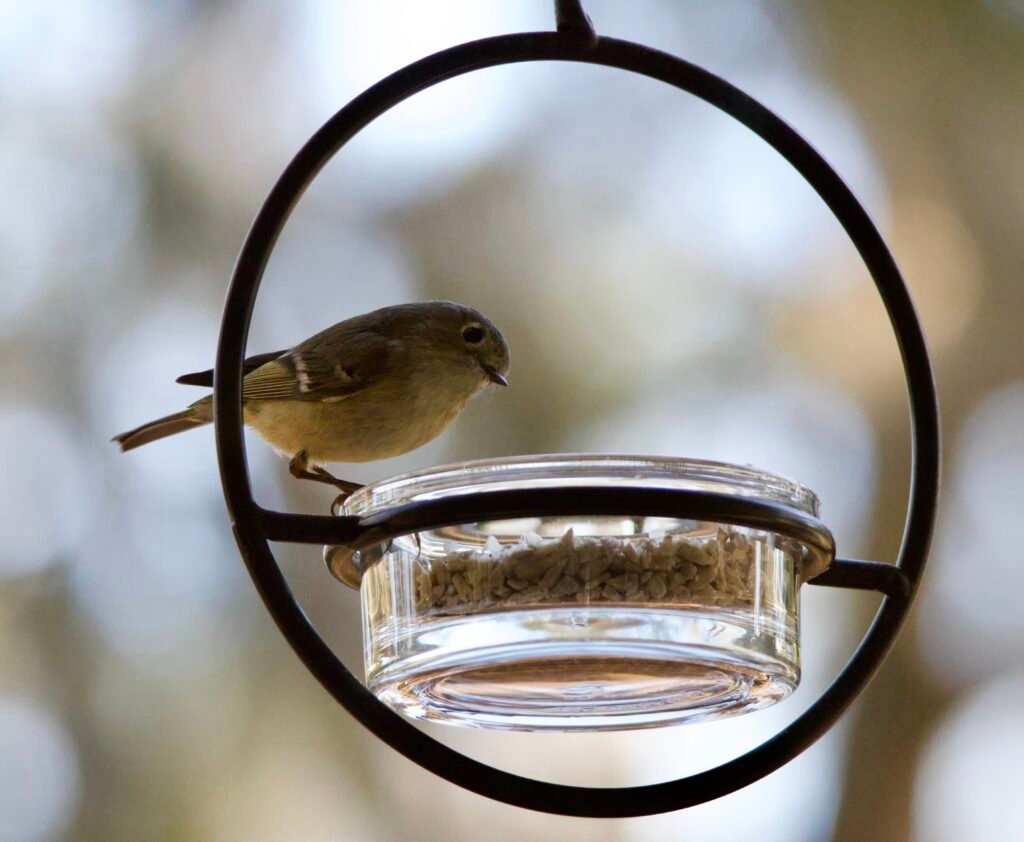
If you’d like to purchase suet for ruby-crowned kinglets, consider getting suet that is a uniform consistency and avoiding those with large chunks of stuff in them. My birds love the SuperSuet available at Wild Birds Unlimited. Its primary ingredients, peanuts, beef fat, mealworms, corn and other nuts, are all ground up into a homogenous block of suet that is seemingly irresistible to most birds. Bark butter is a spreadable form of suet that can be smeared on tree bark or on your other feeders if you don’t want to purchase a suet feeder. One bird enthusiast’s ruby-crowned kinglets are so enamored with bark butter they eat it off his finger.
Project Feederwatch also lists mealworms as a potential food item for ruby-crowned kinglets. I have yet to observe my kinglets eating mealworms, but that doesn’t mean they won’t. As a primarily insectivorous bird, it makes sense that kinglets would eat mealworms and perhaps the ones in my yard are just preferential to other food.

Ruby-crowned kinglets will flit around your yard and feeders until April when they will begin to head north to their breeding areas. But don’t despair, as they leave a number of spectacular summer migrants will be returning to fill the void, including our summer jewel and smallest of all southern birds, the ruby-throated hummingbird.
Want to learn more?
- All About Birds: Ruby-crowned Kinglet
- Audubon Explorer: Ruby-crowned Kinglet (super cool interactive maps)
- Audubon Bird Guide: Ruby-crowned Kinglet
- American Bird Conservancy’s Bird Library: Ruby-crowned Kinglet
- Avian Behavior, Ecology and Evolution: Using song dialects to reveal migratory patterns of Ruby-crowned Kinglet populations by Pandolfino and Douglas
- Thesis 2018: Foraging Ecology of a Winter Bird Community in Southeastern Georgia by Mowbray
- Diversity 2021: Seasonal and Interspecific Variation in Frugivory by a Mixed Resident-Migrant Overwintering Songbird Community by Carter and Others
- Birds of the World 2021: Ruby-crowned Kinglet by Swanson, Ingold and Wallace
- Thesis 2017: Habitat use by wintering passerines in fire-managed forests along the US Gulf Coast by Michaud
- The Condor 2012: Predicting Occupancy of Wintering Migratory Birds: is Microhabitat Information Necessary? By McClure, Rolek and Hill
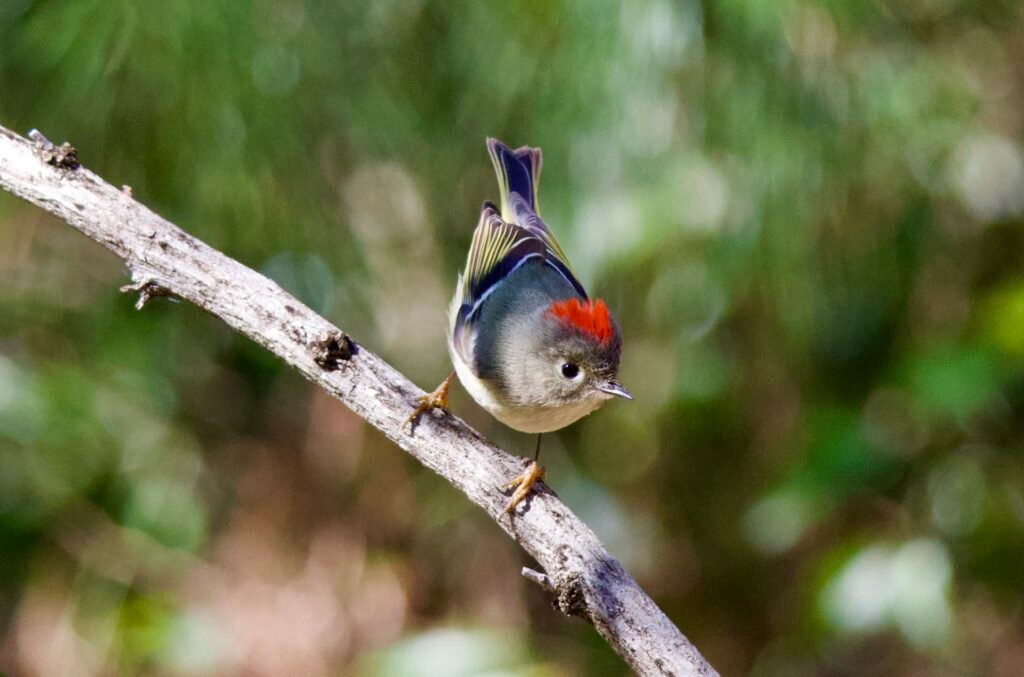
What an informative article about a bird I have trouble identifying. I plan to be diligent in my bird feeder options in NE FL before kinglets fly north. Hopefully I will be successful in attracting this little bird and be better able to identify it. Great article and photos!
Pingback: The Southern Wild - Attracting Yellow-throated Warblers
Pingback: How to Attract Carolina Chickadees - The Southern Wild
Pingback: Birding Basics: The Best Bird Feeder Setup for Beginners - The Southern Wild
Pingback: Raising Mealworms for Wild Birds - The Southern Wild